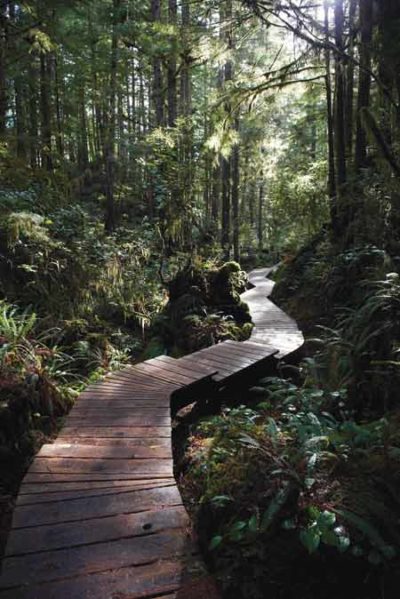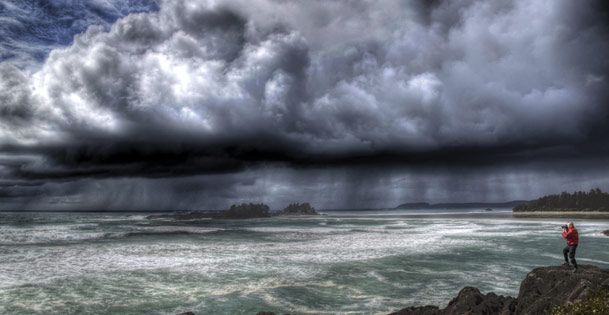From Vancouver, we ferry to Vancouver Island on Canada’s Pacific coast and then drive west on the Pacific Rim Highway, which bisects the island on a winding two-lane road walled by trees on both sides. It’s drizzling, clouds and deep fog nest on the treetops, and a mist drifts eerily across the road, hovering over the glassy panes of still ponds and filling in the open space between mountain passes. Every now and then, a waterfall bursts from the stone-walled sides of tall, sheer hills.
Soon, we are far enough beyond civilization that there are no stores of any kind — the last one we see is out of everything but chocolate bars and crackers — and the radio dissolves into static but for one station that gives a running weather forecast. Tropical storm warnings with gale-force winds at 48 knots, the report says in monotone. Continued rain and storms, with hurricane-force winds expected on the north coast.
“Yes!” I say. “We’re going to get it just right!”
Toni, my wife, looks doubtful, still not 100 percent sold on this excursion. She supposes that maybe there is a reason ours is the only car we’ve seen on the road in the last half-hour or so, and the last ones we saw were headed in the opposite direction.
“I’m telling you,” I say. “It’s going to be great!”

Between October and early March, 10 to 15 fierce tempests a month gather and roll from across the Pacific, unimpeded by any landmass until they crash on the shores here. Sailors know the coast as the “Graveyard of the Pacific,” and chronicles of disasters and survivor stories fill volumes.
When we arrive in Tofino, the town on the coast, I feel reassured: There is no threat of sunshine in sight.
“Oh, a storm is coming all right,” one of the porters promises as we pull into the Wickaninnish Inn, a lodge built into a rocky promontory, whose floor-to-ceiling windows are tempered to withstand 100 mph gusts so guests can look into the heart of the storm without flinching. “It’s a little early for check-in. It’s a nice time to take a walk on the beach.”
“What about the storm?” I ask.
“Oh, we have at least half an hour yet.”
Down on the beach, people stroll in yellow rain slickers, and dogs chase balls and Frisbees. The sea is churning. The sky looks six shades of white and gray, and I can feel pressure in my ears. Surfers in their wet suits look like black bobs on the surface of the water.
We get back inside the hotel ahead of the storm. Rain pelts the windows and taps the roof, strong and steady, and then builds into a real torrent, billions of little beads dropping from the sky. The water’s surface whips into a creamy brown foam, and enormous swells heave and then roll in long seams into waves that explode on the boulders, sending bursts of spume a hundred feet into the air. The wind cuts the crest of the waves like a scythe and slings foam and water. Across from the beach are tiny islands with huge sitka spruce trees so strong that the wind can’t bend them. Everything begins to look like an impressionist painting up close. The susurrations of the water are amplified by a rumbling, a sound of thunder that comes from the sea itself, which we can hear even from within the cozy safety of the lodge, thanks to a pipe that carries the sound in from outside.
Toni says, “This is amazing.”
Once, Tofino was even more remote. The area’s first inhabitants were a First Nations people, the Nuu-chah-nulth. Later came fishermen and loggers, and in the 1960s, Henry David Thoreau disciples and other retreatists discovered the place. In 1970, the Canadian government established the Pacific Rim National Park, a 200-square-mile preserve, and then finished paving a road, Highway 4 (aka the Pacific Rim Highway), which made Tofino considerably more accessible. The early tourists were mostly campers, fishers, and RV adventurers — people who liked their holidays rustic. Today, the 1,875 residents receive about a million visitors a year, though most of them come in season for the water sports and whale watching, not for the storms. In November, the area has a quiet and pleasant off-season feeling, with the summer tourist shops closed and other places keeping irregular hours.
When the Wickaninnish Inn opened in 1996, its cedar-sided building, along with furnishings from recycled old-growth fir, western red cedar, and driftwood, and natural stone tile floors covered by wood sisal carpets, all let the 75-room inn fit the setting. But “the Wick,” as it’s called, was intended as an experience for people who take their rustic neat, without the rugged. Let’s call them (or us, as the case is) the Pampered Traveler — people who appreciate a good double-soaking tub, heated floors, private ocean-facing balconies, in-room fireplaces, and a four-star, full-service spa. An elegant restaurant is perched just beyond the reach of a seething surf channel that’s illuminated at night, to keep you close to the austere experience even as you sip some luscious British Columbia white wine.
Construction was no mean feat. Each massive post of the restaurant is mounted on a steel saddle connected to a concrete post that is anchored deep into the surrounding bedrock. Pairs of 5-foot-wide panes knit by narrow mullions give guests a 260-degree view of awe-inspiring weather in awesome digs.
The Wick inspired similar ventures, among them Long Beach Lodge, Pacific Sands Beach Resort, and Clayoquot Wilderness Resort. They have their critics, who see the luxury trend as antithetical to the roots, if not the ethos, of the place.
For people who live for this, there’s nothing like a good thrashing from 80 mph winds and 4 inches of rain in an hour. “You know you’re alive,” one resident said of the storms. “You feel the wind in your face, taste the salt on your lips.”

Somewhat paradoxically, it’s also an intoxicatingly serene experience, a soothing kind of spectator sport. At night, the storm lingers with a firm wind, and when we open the sliding door on the balcony, only a faintly briny breeze comes in, so we let the fireplace burn, keep the door open, and sleep to the tunes of the surf.
The next morning, it’s teeming again. We’ve planned an interpretive walk with a nature guide on the Wild Pacific Trail that winds along the oceanfront. It is almost redundant, I imagine, to add that it’s a rain-or-shine appointment.
By the time we meet our guide, Bill McIntyre, a slash of pink fills a gap between billowing white clouds. “We have blue sky!” he shouts. “The winds have changed direction.” A biologist who was the chief naturalist to the Pacific Rim National Park Reserve for 25 years, he points out eagles’ nests, explains the science behind the weather, and tells shipwreck stories. Then the crisis passes. The wind returns. A good drenching downpour ensues, which we watch from within the protected cover of the coastal rain forest. Below, the water heaves with awesome force. It makes our guide giddy.

“Whoo-eee!” he cries out as a wave rolls into a boulder with a powerful explosion. Then another, and another. “Look at that! Look, look, look at that one! Pow!”
It’s like watching fireworks. With each explosion, you hope the next one will be bigger, brighter, and more sustained. We loop around to a lighthouse, where a skull-and-crossbones sign warns people not to go beyond, and there stands some lunatic with a camera and a death wish on the boulders with waves crashing at his feet. Bill calls to him to suggest that he might want to back up a little. “Oh, I have a lot of experience,” he calls back. “I’m all right.”
“Idiot,” Bill says to us. “One wave will wash away all that experience.” So we stand for a little while with morbid curiosity, though nothing hideously entertaining follows. Then, with almost violent suddenness, the storm passes and the sky turns blue, as if all the rain rinsed the white out. And when the wind stops, the forest makes a lot of dripping sounds.
When it’s time to go, we refill the tank and get a bag of nuts from a convenience store for the four-hour drive back across the reserve en route to Victoria, the island’s only real city. The shining sun is a shimmering reminder of how lucky we were to experience two storms.
Later, after we come home, a friend says she also was in Tofino once during storm season. “It’s a magnificent place,” she says. “But we had no luck at all. The whole time there was barely a cloud in the sky.”
Become a Saturday Evening Post member and enjoy unlimited access. Subscribe now



